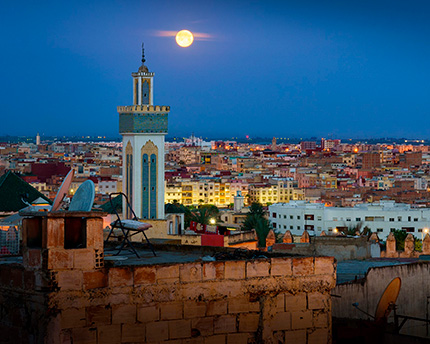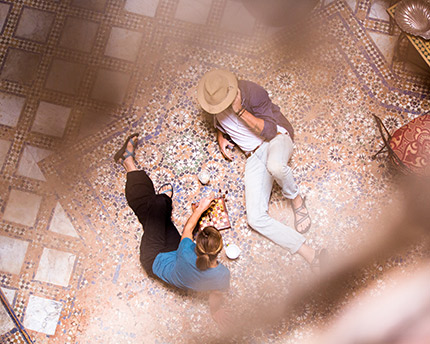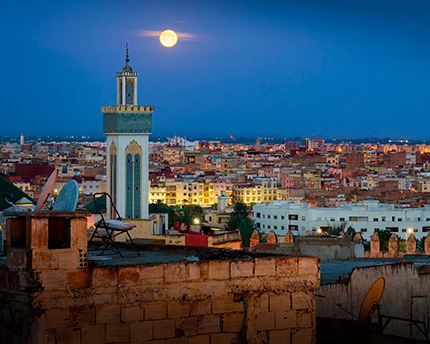The imperial city of Meknes enjoyed its period of greatest splendour many centuries ago. And yet, despite being smaller than neighbouring Fez and receiving fewer visitors, this beautiful city is still a fascinating place to visit. The remains of three complexes of fortifications speak volumes about its important past and today they have been incorporated into its road network. The tomb of the sultan lies in what remains of the original imperial city, flanked by magnificent Bab El Mansur Gate and El Hedim Square, which is like a smaller version of famous Jemaa el-Fnaa in Marrakesh. Meknes has over 40 km of impressive defensive walls and numerous mosques, and it has earned a well justified place on UNESCO’s list of World Heritage Sites thanks to its ancient medina and the remains of its Royal Palace.
History and interesting facts about Meknes
The name Meknes comes from the Miknasa Berber tribe, which settled in the area in the 10th century. The Almohads and Marinids expanded the medina of Meknes and built the oldest monuments to remain in the city today. However, it enjoyed its period of greatest splendour in the 17th century after the death of Sultan Al-Rashid, founder of the ’Alawi dynasty, and the succession of his brother, Moulay Ismail Ibn Sharif, who made Meknes the capital of his kingdom.
Sultan Moulay Ismail built 25 km of walls in Meknes with magnificent gates and a palace complex that was so ambitious it was never completed. He died after a 55-year reign and Meknes was relegated to being a second-class city once more when his grandson, Mohammed III, moved his court to Marrakesh.
Further problems afflicted Meknes when the same earthquake that devastated Lisbon in 1755 also severely affected the city, and rebuilding was extremely slow. It began to recover in 1912 under the French Protectorate when the French made Meknes their military headquarters, until Morocco won its independence.
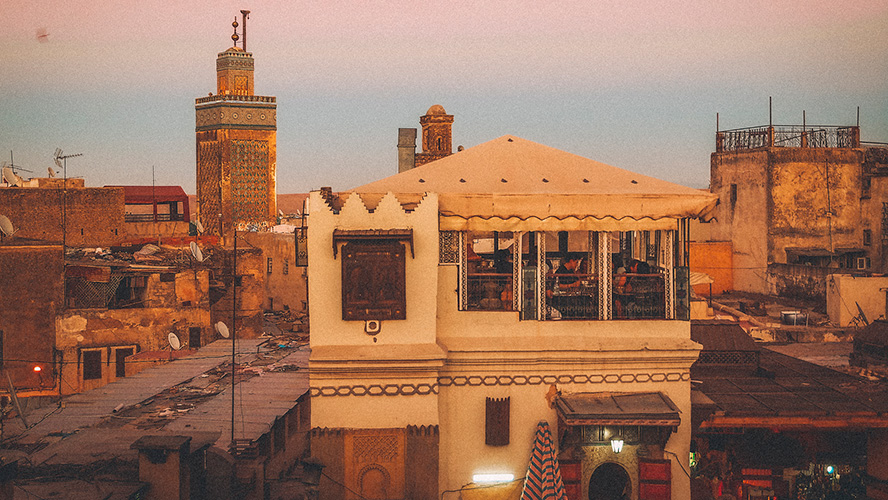
What to see and do in Meknes
Meknes, known as the Versailles of Morocco, has numerous monuments and is a beautiful, welcoming city. It’s also known as the “city of a hundred minarets” and is a highly recommended stop on your holiday to Morocco. Essential things to see in Meknes include:
El Hedim Square. This is the main meeting point in Meknes. It’s the heart of the ancient city and is flanked by magnificent Bab El Mansour Gate. The square was once filled with a kasbah that Sultan Mulay Ismail ordered to be pulled down, and public executions were also once held here. It’s often described as a local version of Jemaa el-Fnaa in Marrakesh and is a fabulous place to stop for a cup of coffee or tea at one of its many restaurants.
Bab El Mansour Gate. This gate leads to the medina and is a masterpiece of Hispano-Muslim art. It’s perhaps the most impressive of all Morocco’s imperial gates and is extremely well conserved; the lower part is covered in inscriptions, one of which reads: “I’m the most beautiful gate in Morocco. I’m like the moon in the sky. Prosperity and wealth are written upon me.” The gate was finished by Moulay Abdallah, son of Sultan Moulay Ismail, in 1732. The white columns on each side are made of Corinthian marble and were sacked from a palace in Marrakesh. The gate only opens on very special occasions.
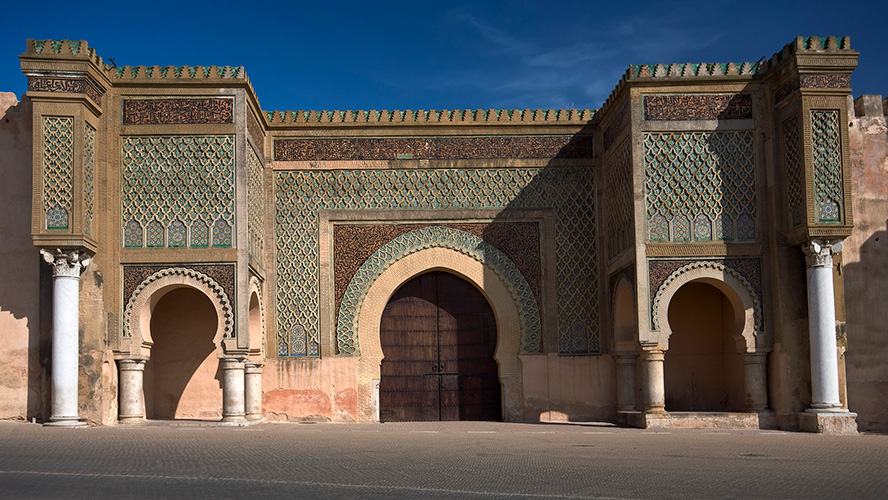
Dar El Makhzen Palace. Also known as the Royal Palace, this complex is in the El Mechouar Stinia area and was the official residence of powerful Sultan Moulay Ismail. It’s surrounded by an impressive 2 km passage, and it transports visitors to the greatness of the period through its fascinating rooms and gardens.
Dar Jamaï Museum. This former palace has views of El Hedim Square and was turned into a museum of traditional ceramics, jewels, fabric and cedar wood carvings in 1920. Its courtyard and Andalusí-style gardens contain wonderful orange trees. The kuba or vaulted sanctuary on the upper floor has been designed to recreate a traditional reception room decorated with rugs and cushions. The palace has a long and turbulent history – when Hassan I died in 1894, the Jama’i family was ostracised from court politics and lost ownership of the palace. The French requisitioned the building in 1912 and used it as a military hospital until it was turned into a museum in 1920.
Mausoleum of Sultan Moulay Ismail. This is the resting place of the sultan who made Meknes his capital in the 17th century and its decoration is an example of the finest Moroccan craftwork. It’s reached through a series of courtyards where silence reigns; non-Muslims can visit but are not permitted to go as far as his tomb.
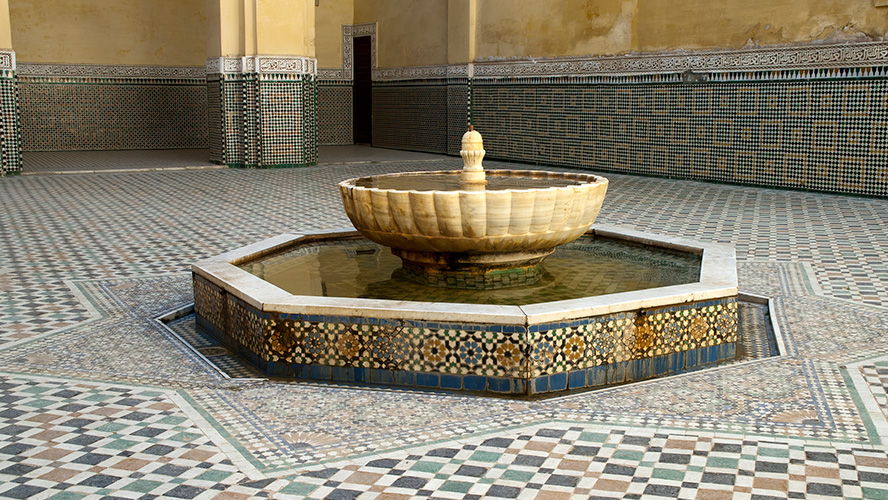
Madrasa Bou Inania. This building is next to the Great Mosque and its decoration exemplifies the elegance of Marinid monuments. It was completed in 1358 by Sultan Abu Inan Faris, who also built another luxurious madrasa in Fez. Visitors can climb up to the rooftop which has views of the roof and green-tiled minaret of the Great Mosque. You can also visit students’ private rooms and the school hall, which has a mihrab that naturally amplifies the acoustics.
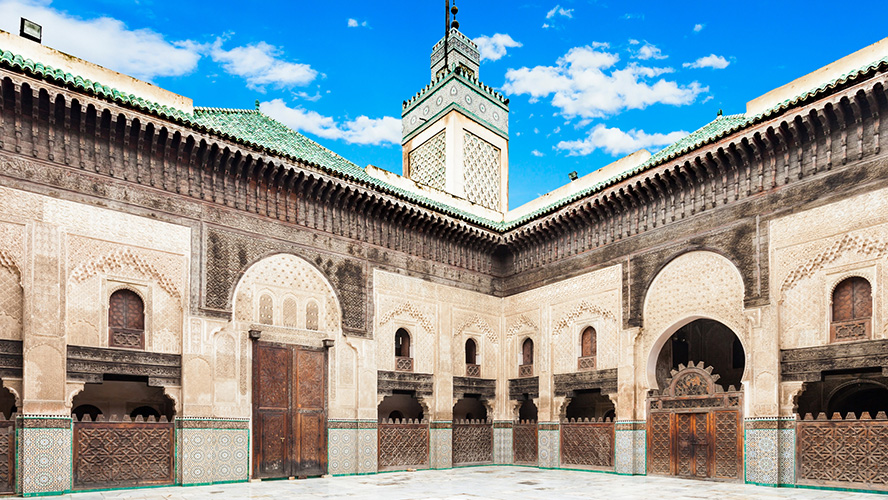
Grand Mosque. Founded in the 11th century by the Almoravids, this mosque stands out for its impressive architecture. It has 11 gates and 143 arches, and its structure and sculptured roofs clearly demonstrate the great skill of the craftsmen of the time. Jamai Roua Mosque is another interesting mosque to visit; it was built in 1790 by Sidi Mohamed Ben Abdellah.
Souk. Enter the souk and you feel as though time has stopped in Meknes medina, even if the artisans have updated the types of goods they craft. It’s fascinating to explore the ancient city’s souk, where you’ll see damask patterns on vases, plates, bracelets, etc. In fact, there are several different souks inside Meknes souk: Lahdim Souk (different types of olive), Sekkakine Souk (knives, teapots and other traditional objects), Bezzazine Souk (basket-weaving and wickerwork), Bab Jdid Souk (musical instruments), Nejjarine Souk (wood and carpentry), Sebbat Souk (shoes, fabric, clothes), El Herir Souk (silk cloth), etc.
What to visit around Meknes
There are numerous tourist attractions near Meknes. The most popular trips from the city include the Roman ruins of Volubilis (30 km) and Fez (60 km) but there are many more beautiful and interesting places to see, particularly if you’re travelling by car, and they often have long, fascinating histories. We recommend visiting the towns of Moulay Idriss (30 km), Moulay Yacoub (60 km), Azrou (66 km) and Rabat (which is further away, about 150 km from Meknes).
How to get to Meknes from Fez
You can travel from Meknes to Fez in several different ways; the cities are 60 km apart and the easiest option is to book a day trip. Guided tours are available in several languages and also include stops at Volubilis and Moulay Idriss. Another option is to hire a taxi for the day. Or you could hire a car and take the A2 – but you’ll have to watch out for rough roads and unpredictable drivers. There are also buses, shared taxis and trains that can transport you to Meknes at very low prices.
Where to stay in Fez
If you’d like to visit Meknes and stay at a hotel where rest and comfort is guaranteed, we recommend choosing the Barceló Fès Medina because it’s excellent value for money. You’ll enjoy a welcoming, four-star hotel right next to the medina, 5 minutes from the train station and 20 minutes from Fès-Saïss international airport. It has 134 modern, fully equipped rooms and comfortable spaces. The hotel has its own international restaurant where you can also enjoy typical Moroccan food, and a Jazz Bar that serves delicious cocktails. Other facilities include a spa where you can unwind, book a treatment and use the sauna, hammam and gym. It’s a wonderful oasis where you’re sure to feel at home.







































































